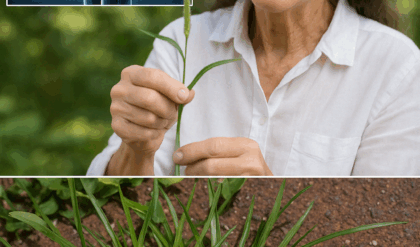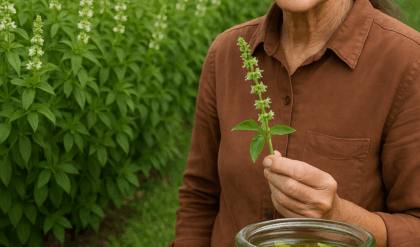What if the unassuming weed you’ve been battling in your garden is secretly a superfood poised to transform your health? Lamb’s quarters, or Chenopodium album, also known as wild spinach or goosefoot, is a leafy green often mistaken for a nuisance but brimming with vitamins, minerals, and antioxidants that rival kale and spinach. This overlooked gem, cherished in traditional cuisines worldwide, offers a free, sustainable way to boost immunity, support digestion, and enhance vitality. In this comprehensive guide, we’ll unveil the science-backed health benefits of lamb’s quarters, creative ways to enjoy it, and why it deserves a starring role in your diet. Ready to turn a common weed into a wellness hero? Let’s dive into the remarkable world of lamb’s quarters.

Why Lamb’s Quarters Is a Superfood Star 🌿
Lamb’s quarters is a nutritional treasure hiding in plain sight. Its tender leaves and young shoots are packed with vitamins A, C, and K, plus minerals like calcium, magnesium, and iron, often surpassing cultivated greens. With a protein content comparable to spinach and antioxidants like beta-carotene, it fights inflammation and oxidative stress. Thriving in gardens and disturbed soils across the globe, this plant has been a dietary staple from India to the Americas. Eco-friendly and cost-free, lamb’s quarters is a sustainable choice for natural wellness enthusiasts.
Science-Backed Health Benefits 🩺
Research and traditional use highlight the impressive benefits of lamb’s quarters, making it a versatile addition to a healthy diet:
- Immune Support: A single cup provides 96% of the daily value for vitamin C and 73% for vitamin A, bolstering immunity and helping ward off infections.
- Bone Health: High calcium (31% DV per 100g) and vitamin K strengthen bones, reducing the risk of osteoporosis.
- Anti-Inflammatory Relief: Flavonoids and beta-carotene reduce inflammation, easing joint pain and supporting chronic disease prevention.
- Digestive Wellness: Fiber promotes regular bowel movements and supports gut health, while mild diuretic properties aid detoxification.
- Heart Health: Potassium and magnesium help regulate blood pressure, promoting cardiovascular vitality, as noted in nutritional studies.
- Skin Healing: Chewed leaves form a paste that soothes insect bites, minor cuts, and sunburns by reducing inflammation.
- Energy Boost: Iron and B vitamins, including riboflavin (37% DV) and B6 (21% DV), combat fatigue and fuel metabolism.
These benefits make lamb’s quarters a nutrient-dense ally for vibrant living.
How to Enjoy Lamb’s Quarters Safely 🍽️
Lamb’s quarters is edible raw or cooked, with leaves, shoots, flowers, and seeds offering culinary versatility. Here’s how to incorporate it:
- Raw Leaves: Toss young, tender leaves into salads for a spinach-like flavor with a subtle salty note from mineral-rich dust.
- Cooked Greens: Sauté, steam, or boil leaves and shoots as a side dish or mix into soups, stir-fries, or casseroles. Cooking reduces oxalic acid in older leaves, which can irritate the throat.
- Seeds: Harvest in fall, dry, and grind into flour for baking or sprout for nutrient-packed microgreens.
- Herbal Tea: Boil leaves for 10 minutes to create a tea that supports digestion and eases stomach discomfort.
Start with small portions to ensure digestive comfort, as oxalic acid in mature leaves may cause issues for sensitive individuals.
Creative Culinary Uses 🎨
Lamb’s quarters adds a creamy texture and mild, earthy flavor to dishes:
- Foraged Salad: Combine young leaves with dandelion greens and almonds for a nutrient-rich salad.
- Smoothie Power: Blend leaves with mango and yogurt for a vitamin-packed drink.
- Seasoning Blend: Dry leaves and grind with spices for a nutritious salt alternative.
- Soup Enhancer: Stir into lentil or vegetable soups for a spinach-like richness and health boost.
These uses make lamb’s quarters a versatile, health-enhancing ingredient.
Precautions for Safe Use ⚠️
While safe for most, lamb’s quarters requires careful handling:
- Moderation: High oxalic acid in older leaves may cause digestive upset or kidney concerns if overconsumed. Cook mature leaves to reduce oxalic acid.
- Foraging Safety: Harvest from clean, pesticide-free areas, as lamb’s quarters often grows in disturbed soils like roadsides.
- Allergies: Test a small amount if new to wild greens, as rare reactions may occur.
- Identification: Confirm the plant’s identity, looking for diamond-shaped, toothed leaves with a waxy, whitish coating, to avoid toxic look-alikes.
Use fresh, young plants from trusted sources for optimal safety and flavor.
Sustainable Wellness with Lamb’s Quarters 🌍
Lamb’s quarters is eco-friendly, thriving without cultivation in marginal soils. Foraging or growing it in your garden supports sustainable practices. By embracing this wild superfood, you reduce reliance on store-bought greens, saving money and minimizing your environmental footprint.
Tips for Making It a Habit 📅
Incorporate lamb’s quarters into your routine by foraging regularly or cultivating a patch in your garden. Use weekly in salads, teas, or cooked dishes for consistent benefits. Pair with healthy habits like staying hydrated or practicing yoga for holistic wellness. Share your lamb’s quarters recipes with friends to inspire a community of foragers and health enthusiasts.





